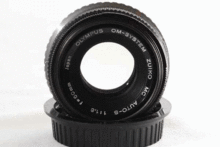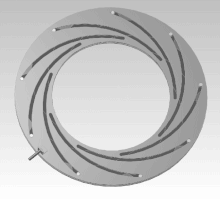Iris diaphragm
In applied optics, iris diaphragm denotes a diaphragm with a variable opening width , the opening of which can be changed with a fixed center point so that it remains approximately circular . Its function corresponds to the iris of the human eye, the technical construction that of a central shutter .
In some other areas, for example in the case of linear accelerators for electrons, fixed circular pinhole diaphragms are also referred to as iris diaphragms.
functionality
The iris diaphragm consists of several lamellas, which can be turned inwards or outwards together via a mechanism. Each lamella is mounted on an axle . All slats are connected with a ring via a further axis so that they move together. The more slats are used, the better the opening can be approximated to the circular shape during adjustment. An opening that is as circular as possible is important if photography is used with blurring, as the aperture shape of the lens used influences the depth of field and thus the bokeh . Points outside of the focus area result in an area on the image that is similar to the shape of the diaphragm opening , for example a hexagon if the iris diaphragm is hexagonal.
application
Iris diaphragms can be opened and closed by hand or with a motor drive, depending on the design. In optical systems they are usually attached in the immediate vicinity of a main plane in order to limit the effective opening width of an optical element and thus to control the brightness of the image.
The properties and purpose of an iris diaphragm are very similar to those of the iris in the eyes of humans and animals.
Digital compact cameras often do not have an iris diaphragm, but rather a pivotable neutral density filter or a simple snap-on diaphragm. Unlike an aperture, a filter does not affect the focus area.
history
In the 19th century, perforated metal disks, which were pushed through a lateral gap between the lens sets, were common for dimming photographic lenses. In a lecture entitled “Die Sichelblende” to the Viennese Photographic Society on January 18, 1887, Max Jaffé suggested making the lamellae sickle- shaped and rotating them not around fixed, but sliding axis points. This saves installation space and enables apertures that are better adapted to the circular shape. In addition, these proposals made it possible to improve the designs at that time, such as those made by Anzoux & Français in Paris , which previously only allowed very large minimum apertures and no external assessment of the hole diameter.
Iris diaphragms were used in film especially during the silent film era : They often reduced the visible image section in order to point out a certain detail in the image.
literature
- Uwe Ney: Modern Narrow Film Practice. Falkenverlag. ISBN 3-8068-4043-1


